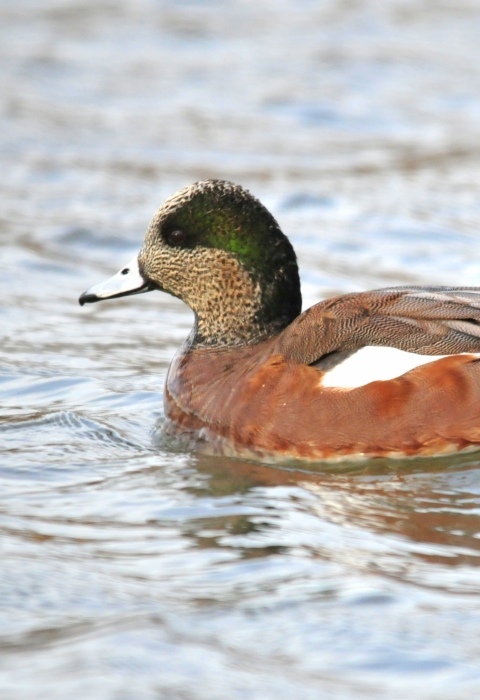Overview
American wigeon are a medium-sized dabbling duck. Males have a distinctive white patch on their head that historically gave them the nickname baldpate. This species can be aggressive when competing for food and is a highly flexible forager - equally at home stealing food from diving ducks in deep water or grazing on turf grasses in urban areas.
Identification Numbers
Characteristics
Habitat
These ducks are common on small cattle ponds throughout the Great Plains and will use managed moist-soil wetlands, playas and agricultural areas during migration and winter periods. American wigeons seek to feed on submersed aquatic vegetation, but they can also be seen waddling on land grazing on turf grass and other low-growing vegetation. Many national wildlife refuges purposely flood some managed wetlands in early fall for early migrants, such as American wigeon, to provide food and sanctuary conditions.
Food
The American wigeon diet consists largely of aquatic plant material. Known for being opportunistic, they will feed in close proximity to diving ducks and swans to steal plant matter those species bring to the surface. Flocks can also sometimes be seen grazing for food on land more often than other duck species. There is an increase in consumption of animal matter, such as snails and water beetles, during breeding season by females preparing for egg laying.
Physical Characteristics
American wigeon are medium-sized ducks with a short bill and a round head. Males, in breeding plumage, have a brownish gray head with a wide green stripe behind the eye and a gleaming white cap or baldpate. The body is pale cinnamon with white patches on the sides of the rump that contrast with the black undertail feathers.
Measurements
Length: 16.5 to 23.2 in (42 to 59 cm)
Wingspan: 33.1 in (84 cm)
Males, in breeding plumage, have a brownish gray head with a wide green stripe behind the eye and a gleaming white cap or baldpate. The body is pale cinnamon with white patches on the sides of the rump that contrast with the black undertail feathers. Females are mottled brown with a brownish or grayish head. Both sexes have a pale blue bill.
One of the more vocal dabbling ducks with a whistled whew-whew-whew. Females have a loud kaow and a lower qua-awk.
While they can be an aggressive feeder with other waterfowl species, the American wigeon is a wary of the unknown and will flush easily. During hunting seasons, they tend to be even more wary and may become nocturnal feeders.
Behavior
While they can be an aggressive feeder with other waterfowl species, the American wigeon is wary of the unknown and will flush easily. During hunting seasons, they tend to be even more wary and may become nocturnal feeders.
Life Cycle
Females will lay nine to 11 white to cream colored eggs in a nest lined in down feathers with a base of grasses.
Geography
American wigeons occur across all four North American flyways, but they are most abundant in the Pacific and Central flyways. Nesting occurs primarily on the ground in the northern tundra, boreal forest and prairie parklands of Canada with abundance in areas of the Prairie Pothole Region increasing. American wigeons migrate and reach their wintering grounds earlier than other species of dabbling ducks, except blue-winged teal. They begin their southward migration in late August to early September with their destination in the Central Flyway being primarily Texas and Mexico and central California in the Pacific Flyway.
